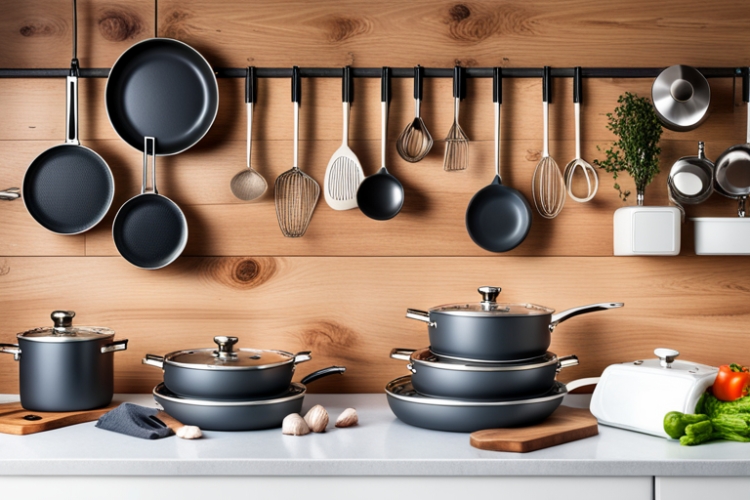Ceramic pans have become increasingly popular in recent years as a potential safer alternative to traditional nonstick cookware. With concerns over the possible health risks associated with the chemicals used in nonstick coatings, many people are seeking out alternatives that are both effective and safe to use. But do ceramic pans truly offer a solution to these concerns? In this blog post, we will explore the benefits and drawbacks of ceramic pans and discuss whether they are a worthy investment for those looking to make a switch in their kitchen. By the end of this article, you'll have a better understanding of whether ceramic pans offer a safer and more reliable option for your cooking needs.
Are ceramic pans a safer alternative to traditional nonstick cookware, addressing health concerns and providing a chemical-free cooking experience?
Yes, ceramic pans are indeed a safer alternative to traditional nonstick cookware when it comes to addressing health concerns and providing a chemical-free cooking experience. Traditional nonstick pans often contain toxic chemicals like perfluorooctanoic acid (PFOA) and polytetrafluoroethylene (PTFE), which can be harmful to human health when overheated or scratched. Ceramic pans, on the other hand, are made from inorganic minerals and do not contain these harmful chemicals. This ensures that no toxic fumes or particles are released into the food, providing a healthier cooking experience.
In addition to being chemical-free, ceramic pans offer other health benefits. Unlike traditional nonstick pans, ceramic pans have a non-reactive surface. This means that they do not leach any harmful substances into the food, even when cooking acidic or alkaline ingredients. This non-reactive surface also makes ceramic pans an excellent choice for individuals with allergies or sensitivities, as they do not transfer any flavors or odors from previous meals.
Overall, ceramic pans provide a safer cooking alternative compared to traditional nonstick cookware. They eliminate the health concerns associated with chemical coatings, ensuring a chemical-free cooking experience. Additionally, their non-reactive surface makes ceramic pans a healthier choice for those with dietary restrictions or sensitivities. So why not make the switch to ceramic pans and enjoy a safer and healthier way of cooking?
By knowing the health and safety benefits of using ceramic pans, you are now able to confidently explore the world of baking. From flaky pastries to gooey cakes, ceramic pans can bring out the best in your baked creations. Say goodbye to the worries of chemical contamination or off-flavors in your baked goods, as ceramic pans provide a reliable and chemical-free baking experience. So why not revolutionize your baking game by incorporating ceramic pans into your kitchen repertoire?
How does the ceramic coating of cookware affect heat distribution and food quality during stovetop cooking?
How does the ceramic coating of cookware affect heat distribution and food quality during stovetop cooking? This is a question that many home cooks have been pondering as they search for safer alternatives to traditional nonstick pans. Ceramic pans have gained popularity in recent years due to their perceived health benefits and nonstick properties. But what exactly does the ceramic coating bring to the table?
Ceramic coatings on cookware have a unique property of distributing heat evenly across the surface. This means that your food will cook more uniformly, reducing the risk of burnt or unevenly cooked dishes. The ceramic coating acts as a barrier between the metal surface and the food, preventing direct and intense heat contact. This allows for gentle and even heat distribution, resulting in tender and perfectly cooked meals.
In terms of food quality, the ceramic coating also offers some advantages. Because food is less likely to stick or burn, you can cook with less oil or fat, promoting healthier eating habits. Additionally, the non-reactive nature of ceramic makes it a great choice for cooking acidic or highly seasoned dishes, as it will not react with the ingredients and alter the flavors. This means that your dishes will taste just as intended, without any metallic or off-flavors.
The question of how the ceramic coating of cookware affects heat distribution and food quality during stovetop cooking is essential when it comes to baking. Baking relies heavily on even heat distribution to ensure that goods rise properly and bake evenly. By understanding how ceramics distribute heat, bakers can choose the right cookware to achieve consistent and delicious results. To delve further into this topic and learn more about the benefits of ceramic pans, read the full article on our website.
Are ceramic pans scratch-resistant and easy to clean, ensuring long-lasting use and convenience in the kitchen?
Yes, ceramic pans are scratch-resistant and easy to clean, making them an excellent choice for long-lasting use and convenience in the kitchen. The ceramic coating on these pans provides a smooth cooking surface that resists scratches and can withstand everyday use. Unlike traditional nonstick pans, ceramic pans do not contain harmful chemicals like PFOA or PTFE, making them a safer alternative for your health.
When it comes to cleaning, ceramic pans are a breeze. The smooth surface of the ceramic coating prevents food from sticking, making it easy to wipe away any residue with a damp cloth or sponge. Additionally, ceramic pans are often dishwasher-safe, which adds to their convenience and ease of use. With proper care, including avoiding the use of metal utensils and abrasive cleaning tools, ceramic pans can maintain their scratch-resistant and easy-to-clean properties for a long time.
As an expert in the culinary world, the question of whether ceramic pans are scratch-resistant and easy to clean is important for baking. Baking requires precise temperature control and even heat distribution, which ceramic pans can provide. The scratch-resistant surface ensures that no metal particles or flakes end up in your baked goods, ensuring their quality and safety. Additionally, the easy-to-clean nature of ceramic pans allows for quick and efficient cleanup, saving you time and effort in the kitchen.
Are ceramic pans oven-safe and resistant to high temperatures, allowing versatile cooking options for baking enthusiasts?
Are ceramic pans oven-safe and resistant to high temperatures, allowing versatile cooking options for baking enthusiasts?
Yes, ceramic pans are indeed oven-safe and resistant to high temperatures, making them a fantastic option for baking enthusiasts. Unlike traditional nonstick pans, ceramic pans are made with a natural coating that does not contain harmful chemicals like PFOA or PTFE. This means that you can bake bread, pastries, and other tasty treats in a ceramic pan without worrying about any toxins leaching into your food. Additionally, ceramic pans distribute heat evenly, ensuring that your baked goods come out perfectly cooked and golden brown every time.
This question and answer can greatly improve the baking experience for enthusiasts as it highlights the benefits of using ceramic pans in the oven. With their high temperature resistance, baking enthusiasts can confidently experiment with various recipes that require higher temperatures without the fear of damaging their pans. The even heat distribution of ceramic pans also helps to ensure that baked goods are cooked evenly, resulting in consistent and delicious results. Furthermore, knowing that ceramic pans are a safer alternative to traditional nonstick pans provides peace of mind for those who are conscious of the potential health risks associated with certain chemicals used in cookware.
In what ways are ceramic pans considered eco-friendly, promoting sustainable choices for the environmentally conscious consumer?
Ceramic pans are considered eco-friendly and promote sustainable choices for the environmentally conscious consumer in several ways. First, ceramic pans are free from harmful chemicals such as PFOA PTFE, commonly found in traditional nonstick pans. These chemicals can release toxins into the air when heated and potentially contaminate the food we cook. By opting for ceramic pans, we are making a safer choice for our health and the environment.
Furthermore, ceramic pans are known for their durability. They are made from natural materials like clay and minerals, which can withstand high temperatures without deteriorating. This means that ceramic pans have a longer lifespan compared to nonstick pans, reducing the need for frequent replacements and ultimately reducing waste.
Additionally, ceramic pans have excellent heat distribution properties. They heat up quickly and evenly, allowing you to cook your food more efficiently. This means you can save energy and reduce your carbon footprint by using ceramic pans. So, not only are you making a sustainable choice by avoiding harmful chemicals, but you are also being eco-friendly by conserving energy while cooking.
These are great questions that demonstrate your commitment to making informed choices in the kitchen. By understanding the advantages of ceramic pans, you can enhance your culinary skills and make healthier, more sustainable meals. Remember, cooking is not only about the flavors and ingredients but also about making responsible choices that benefit both your health and the environment. So, as you explore new recipes and cuisines, consider adding ceramic pans to your kitchen arsenal for a safer and eco-friendly cooking experience.
Conclusion
The ceramic coating on ceramic pans makes them a safer alternative to traditional nonstick cookware because they are nontoxic and chemical-free. Many individuals are seeking healthier cooking utensils due to health concerns about the use of nonstick materials. Ceramic pans not only provide a scratch-resistant and easy-to-clean surface, but they also offer even heat distribution, ensuring high-quality food and eliminating the risk of hotspots during stovetop cooking. Furthermore, ceramic pans are oven-safe and have excellent temperature resistance, making them a versatile choice for various cooking techniques. Their long-lasting durability, coupled with their eco-friendly nature, makes ceramic pans a practical investment for those looking to improve their cooking experience while prioritizing their health and the environment. By choosing ceramic pans over traditional nonstick options, readers can make a positive impact on their lives by safeguarding their well-being and reducing their carbon footprint in the kitchen.



